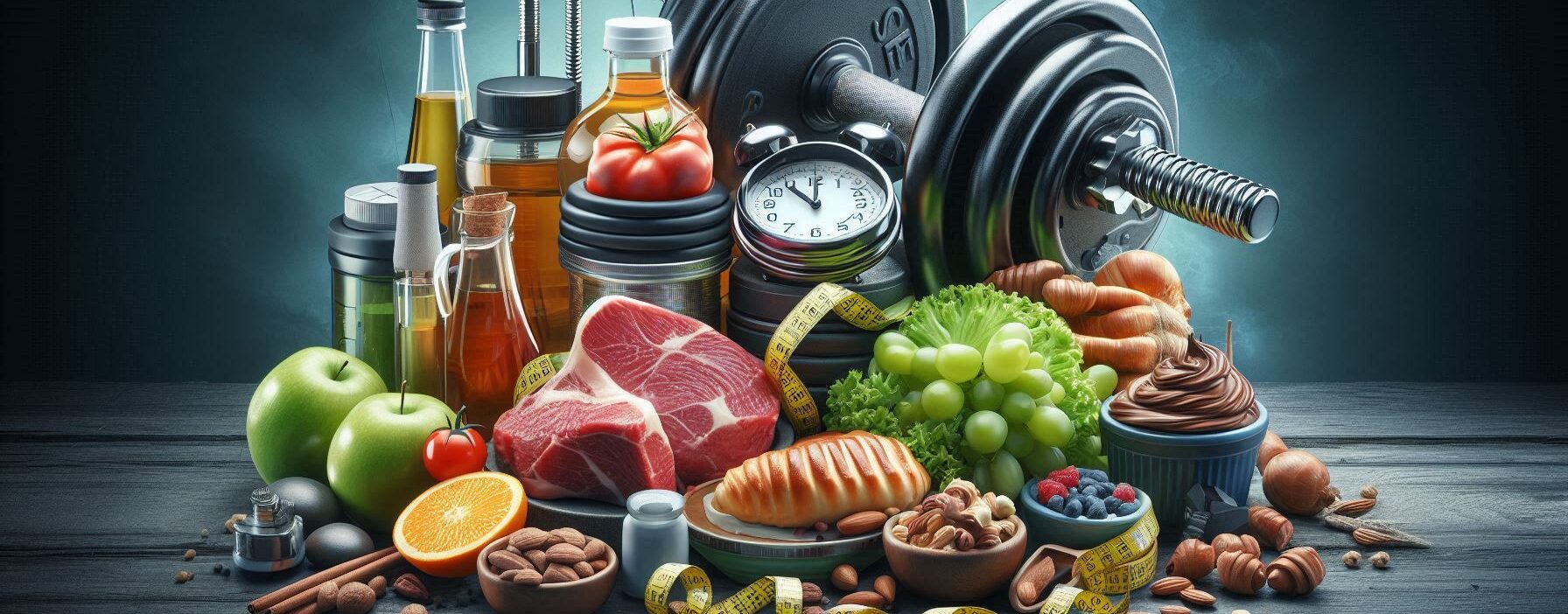When it comes to achieving your fitness goals, we often focus on workouts and sweat. But let’s be honest—what you put on your plate can be just as crucial, if not more so! That’s where fitness nutrition steps in, transforming our food choices into powerful allies in our quest for health. It’s like having a secret weapon tucked away in your pantry!
So, what exactly does fitness nutrition entail? Well, it’s about fueling your body with the right foods to support your workout routine and overall well-being. Think of it as giving your car premium gasoline instead of that cheap stuff—it runs better! Let’s explore how to make smart nutritional choices that will keep you energized and ready to tackle any challenge.
Top Takeaways and Key Concepts
Fuel workouts with balanced macronutrients by eating complex carbs, lean proteins, and healthy fats daily.
Time meals around workouts by eating light carbs before exercise and protein afterward for recovery.
Stay hydrated consistently by drinking water throughout the day instead of relying on sugary sports drinks.
Choose smart snacks that are nutrient-dense to boost energy without derailing fitness goals.
Plan meals ahead to avoid unhealthy last-minute food choices and maintain consistent nutrition.
Summary of This Article
This article explains how fitness nutrition plays a vital role in achieving health and workout goals. It covers the three essential macronutrients—carbohydrates for energy, proteins for muscle repair, and healthy fats for hormone balance and nutrient absorption. It also stresses the importance of proper meal timing before and after workouts to improve performance and recovery. Hydration is highlighted as a key factor, with water being the top choice except during prolonged intense exercise. The article also encourages smart snacking, portion control, and planning meals ahead to stay consistent and avoid unhealthy eating habits. Ultimately, fitness nutrition is about fueling your body with intention to feel strong, energized, and healthy.
Video Summary
Please Note: This post may contain affiliate links. If you click one of them, we may receive a commission at no extra cost to you. As an Amazon Associate, I earn from qualifying purchases.
Jump to Content Section
Shortcuts to Exercise Equipment Shopping at Amazon
Ellipticals - Exercise Bikes - Recumbent Bikes - Treadmills - Rowers
Dumbbells - Resistance Bands - Kettlebells - Benches - Pull-up Bars
Understanding Macronutrients: The Big Three

To kick things off, let’s talk about macronutrients—the three main components of our diet: carbohydrates, proteins, and fats. Each one plays a unique role in keeping us fueled and functioning at our best.
Carbohydrates are often misunderstood; they’re not the enemy! In fact, they’re your body’s primary energy source. Imagine trying to run a marathon without any gas in the tank—yikes! Foods like whole grains, fruits, and veggies provide the necessary carbs to power through those tough workouts. So next time someone tells you to cut out carbs completely, maybe give them a puzzled look and ask why they would want to sabotage their own energy levels!
Then there are proteins—these guys are the builders of our bodies. They help repair muscles after that intense gym session or long run. Chicken breast, fish, beans—you name it—are all protein-packed options that can aid recovery and promote muscle growth. Honestly, who doesn’t love digging into a delicious piece of grilled salmon after leg day?
Finally, let’s not forget about fats! Yes, I said fats! It seems like just yesterday we were all on the “fat is bad” bandwagon, right? But here’s the scoop: healthy fats are essential for our bodies and play a critical role in overall wellness. Think of them as the unsung heroes in your nutrition plan, quietly working behind the scenes to support everything from hormone production to nutrient absorption.
So, what exactly are these “healthy fats”? Well, they come from sources like avocados, nuts, seeds, olive oil, and fatty fish such as salmon. These foods are packed with monounsaturated and polyunsaturated fats—types that can help lower bad cholesterol levels while boosting good ones. Can you imagine munching on some creamy avocado toast or tossing a handful of walnuts into your salad? Not only do they taste great, but they also deliver a nutritional punch!
Interestingly enough, healthy fats help our bodies absorb fat-soluble vitamins—A, D, E, and K. Without adequate fat intake in your meals, you might be missing out on those vital nutrients that keep your skin glowing and bones strong. Picture this: you whip up a colorful salad filled with vibrant veggies but skip the dressing. Without adding something like olive oil or an avocado slice to that bowl of greens, you’re leaving those important vitamins hanging out alone without any way to get absorbed!
Then again, let’s talk about hormones because this is where things get really interesting! Fats are crucial for producing hormones like testosterone and estrogen which regulate various bodily functions—from metabolism to mood swings. Ever feel cranky or off-balance? A diet low in healthy fats might be part of the problem. Incorporating wholesome sources into your meals can help maintain hormonal harmony—talk about a win-win!
But before you dive headfirst into a tub of peanut butter (as tempting as that sounds), moderation is key! While healthy fats have numerous benefits when consumed appropriately; overindulging can lead to extra calories sneaking into your diet faster than my cat stealing my lunch! The goal should be balance—not deprivation or excess.
Incorporating healthy fats into your fitness nutrition doesn’t mean sacrificing flavor either. Who wouldn’t want to drizzle some rich balsamic vinaigrette over their roasted vegetables or enjoy a luscious almond butter smoothie post-workout? So go ahead—embrace those good-for-you fats! They’re not just tasty; they’re vital allies on your journey toward optimal health and performance.
Meal Timing: When Should You Eat?

Now that we know what types of food fuel us best let’s dive into meal timing because it matters too! Have you ever heard the saying “you are what you eat”? Well, I think it should also say “when you eat” matters too!
Eating before a workout is crucial for optimal performance. You wouldn’t try driving a car without filling up its tank first—so why do that with your body? Ideally, aim for something light yet energizing about 30 minutes before exercising. A banana or some yogurt could work wonders without leaving you feeling sluggish.
Post-workout meals deserve special attention too because this is when recovery happens! After sweating buckets at the gym or running like there’s no tomorrow, your muscles need nourishment ASAP! Consuming protein-rich snacks within an hour after working out helps speed up recovery and rebuild muscle fibers—a win-win situation if I’ve ever seen one!
However—and this is important—don’t skip meals throughout the day thinking it’ll help shed pounds faster; trust me on this one! It might seem like a smart strategy to cut calories by skipping breakfast or lunch, but let me tell you, it’s more of a recipe for disaster than success. When you skip meals, your body goes into panic mode, and that’s when those hunger pangs hit harder than an unexpected thunderstorm during summer picnic season.
Picture this: you wake up late and decide to rush out the door without breakfast. By noon, your stomach is growling louder than a hungry bear, and suddenly, all that self-control you had in the morning vanishes like ice cream on a hot day. You find yourself face-to-face with a vending machine or that tempting pizza place down the street. Before you know it, you’re shoving food into your mouth like there’s no tomorrow! Sound familiar?
Interestingly enough, research shows that people who regularly eat balanced meals tend to consume fewer calories overall compared to those who skip meals. Why? Because eating regularly helps keep blood sugar levels stable and prevents those wild cravings from taking over your life. When we fuel our bodies consistently throughout the day with nutritious foods—think whole grains, lean proteins, fruits, and veggies—we’re not only keeping energy levels up but also avoiding the dreaded binge-eating scenario.
Then again, let’s talk about metabolism because this is where skipping meals can really backfire. Your metabolism is like a furnace; if you don’t feed it regularly with healthy foods, it slows down significantly. This means that instead of burning calories efficiently throughout the day, your body decides to conserve energy since it thinks food might be scarce. And who wants their metabolism acting like it’s hibernating during winter? Not me!
To make things even clearer: consider how many times you’ve said “I’ll just skip lunch” only to end up devouring half of whatever delicious leftovers are in sight later on! Skipping meals often leads us to make poorer food choices when we finally do eat because we’re so hungry that anything looks good—even that questionable mystery meat sandwich lurking in the fridge.
So what should you do instead? Well, I suggest planning small snacks or mini-meals every few hours to keep your energy levels steady and hunger at bay. Think yogurt with some fruit or a handful of nuts paired with an apple—simple yet satisfying options! This way, you’re fueling your body while preventing those ravenous urges from taking control of your decisions.
In summary, skipping meals may seem like an easy shortcut to weight loss—but trust me—it usually leads straight into trouble! Instead of playing hide-and-seek with nutrition throughout the day, embrace regular meal times filled with wholesome foods. Your body will thank you for it by feeling energized rather than hangry!
Hydration: The Unsung Hero

Speaking of storms…let’s chat about hydration because it’s truly an unsung hero in fitness nutrition! Water plays such an essential role in keeping us healthy; it’s like magic juice for our bodies (minus sparkles). Did you know even mild dehydration can impact performance? Just imagine trying to sprint while feeling parched—definitely not fun!
I always keep my trusty water bottle nearby during workouts because staying hydrated helps maintain energy levels and keeps joints lubricated (yes please!). If plain old H2O gets boring after a while—and I get it; sometimes drinking water feels like watching paint dry—try infusing it with slices of citrus or berries for added flavor!
Interestingly enough, sports drinks aren’t always necessary unless you’re engaging in prolonged exercise sessions lasting over an hour—or if you’re sweating buckets under the hot sun during outdoor activities. I mean, have you ever seen someone chugging a neon-colored drink after just a quick jog around the block? It’s like using a fire hose to water a tiny plant! For most regular workouts though? Water remains king!
Let’s break this down. When you’re exercising for less than an hour—like that brisk walk or your usual gym routine—your body doesn’t lose enough electrolytes and fluids to warrant anything fancy. In fact, drinking plain old water is usually more than sufficient. It’s like the trusty friend who shows up every time you need them without any drama or frills. Hydration is key, but it doesn’t have to come with flashy labels and bright colors.
Now, if you find yourself running marathons or doing those intense two-hour spin classes where you feel like you’ve just emerged from a sauna, then sure, grab that sports drink! These beverages are designed to replenish electrolytes (you know, those little things your body needs) lost through sweat and provide quick energy from carbohydrates. They can be helpful when you’re pushing your limits in extreme conditions—just think about how much salt comes off during those sweaty sessions!
However, let’s not forget that many of these drinks are loaded with sugars and calories that can quickly add up if you’re not careful. Honestly, do we really need all that extra sugar when we could simply hydrate with good ol’ H2O? If your workout isn’t extreme enough to require replenishing electrolytes, sticking with water will keep things simple—and way healthier!
Speaking of hydration strategies, it’s important to listen to your body too. Are you feeling thirsty? That’s your cue! Thirst is nature’s way of saying “Hey buddy, I need some fluid here!” So don’t ignore it; reach for that water bottle instead of waiting until you feel parched like a desert cactus.
Another fun tip: try carrying a reusable water bottle with you everywhere! It’ll serve as a constant reminder to stay hydrated throughout the day—not just during workouts. Plus, there’s something undeniably satisfying about sipping from your stylish bottle while conquering life like the hydration champion you are!
In conclusion, while sports drinks definitely have their place in certain situations—like ultra-marathons or long hikes—they’re not essential for everyday exercise routines. For most people hitting the gym or going for casual runs? Water is absolutely perfect. Stay hydrated and keep it simple; after all, sometimes less really is more!
Snack Smart: Choosing Nutrient-Dense Options

Let’s face it: snacking is part of life—we all do it! But how do we ensure those little munchies align with our fitness goals? To be fair, reaching for chips might feel satisfying momentarily but won’t do much good when chasing down those gains.
Instead of letting cravings dictate snack choices (hello chocolate chip cookies!), consider healthier alternatives packed with nutrients instead. Think apple slices paired with almond butter or Greek yogurt topped with fresh berries—a delightful combo that satisfies sweet tooth cravings while nourishing muscles simultaneously!
Also worth mentioning here is portion control because sometimes less really is more—even when indulging ourselves occasionally isn’t harmful either! I mean, who hasn’t found themselves staring at a giant slice of chocolate cake and thinking, “Just one more bite won’t hurt”? But here’s the kicker: moderation allows us room for treats without derailing progress entirely.
Let’s face it; we live in a world where food is everywhere, and it often comes in portions that could feed a small army. Whether you’re out at a restaurant or munching on snacks during movie night, those generous servings can make it easy to overeat without even realizing it. It’s like being caught in a delicious trap! That’s where portion control steps in as your trusty sidekick.
Imagine this: instead of diving headfirst into that massive bowl of pasta (which looks like something straight out of an Italian feast), try using a smaller plate or bowl. Psychologically speaking, our brains are wired to feel satisfied when our plates look full. So if you fill up a smaller dish, you might find yourself just as happy—and with fewer calories consumed! It’s kind of like magic but without the smoke and mirrors.
Now, let’s not forget about those sweet indulgences we all crave from time to time. Having dessert doesn’t have to be an all-or-nothing scenario. You can absolutely savor that piece of cake or scoop of ice cream while still keeping your goals intact. The trick lies in understanding that enjoying treats doesn’t mean going hog wild every day! A little bit here and there can satisfy cravings and keep you from feeling deprived—because trust me, deprivation leads to rebellious binge-eating faster than you can say “chocolate chip cookies!”
One effective strategy I’ve found is to plan for indulgences. If you know you’re heading to a birthday party with cake involved, consider having lighter meals earlier in the day so you can enjoy that slice guilt-free later on. This way, you’re not left feeling like you’ve blown your diet; instead, you’re celebrating life while staying on track!
Speaking of celebrations, let’s talk about social gatherings where food abounds—think potlucks or family dinners. These situations can be tricky since everyone seems eager to pile their plates high with every dish available (and honestly, who can blame them?). Here’s where mindful eating comes into play: take your time savoring each bite rather than inhaling everything in sight. Enjoy the flavors and textures; this will help you feel fuller faster and give you permission to stop when you’ve had enough.
In conclusion, portion control isn’t about deprivation; it’s about balance! By practicing moderation and being mindful of how much we eat—even when indulging—we create space for enjoyment without compromising our health goals. So next time that tempting treat calls your name, remember: less truly can be more!
Planning Meals Ahead: Setting Yourself Up for Success
All things considered…meal planning can save lives—or at least save time spent standing bewildered staring at empty fridge shelves wondering what on earth constitutes dinner tonight.
Taking some time each week to prepare meals means fewer last-minute decisions leading us straight toward takeout menus filled with greasy options—not ideal if aiming towards healthier living habits long-term!
Start by jotting down ideas based around seasonal ingredients available locally; then create shopping lists accordingly so nothing goes wasted once back home again (because who wants wilted lettuce hanging around?). I mean, let’s be honest: there’s something incredibly satisfying about wandering through a local farmer’s market and seeing all the vibrant colors of fresh produce. It’s like nature decided to throw a party, and you’re invited!
When you focus on seasonal ingredients, not only are you supporting local farmers, but you’re also getting the freshest and tastiest food available. Ever bitten into a ripe summer tomato? It’s like a flavor explosion in your mouth compared to those sad, out-of-season ones that taste more like cardboard. So why not take advantage of what Mother Nature has to offer at different times of the year?
To kick things off, grab a notebook or open up your favorite notes app—whatever floats your boat—and start brainstorming meal ideas that highlight those seasonal goodies. Think about what’s in season during each month: juicy strawberries in spring, sweet corn in summer, hearty squash in fall, and citrus fruits in winter. The possibilities are endless! You could whip up a refreshing salad with crisp cucumbers and tomatoes for summer picnics or cozy up with a warm butternut squash soup as the leaves change color outside.
Once you’ve got your list of delicious dishes ready to go, it’s time to create your shopping list. This part is crucial because we all know how easy it is to stroll through the grocery store and get distracted by shiny packages or enticing snack aisles. By having a clear plan in hand—like some sort of culinary treasure map—you can stay focused on what’s important. I suggest organizing your list by sections of the store too; this way, you won’t find yourself wandering aimlessly through the cereal aisle when you really need kale!
Now let’s talk about waste—nobody likes throwing away food that went bad before they had a chance to enjoy it! With your handy-dandy shopping list based on seasonal ingredients, you’ll reduce the chances of bringing home items that end up wilting in the fridge like forgotten relics from last week’s meals. And trust me, there’s nothing quite as sad as opening your crisper drawer only to discover an army of limp veggies staring back at you.
Another fun tip? Consider making extra servings when cooking with these seasonal ingredients so you can have leftovers for lunch or dinner later in the week. Not only does this save time (and sanity) during busy days ahead, but it also ensures those delightful flavors don’t go unappreciated!
In conclusion, planning meals around seasonal ingredients isn’t just practical; it’s also an adventure waiting to happen! You’ll discover new recipes while enjoying fresher flavors—all while keeping waste at bay. So grab that notebook and start dreaming up delicious dishes; who knows what culinary masterpieces await?
Suggested Resources
“Nutrition Basics”
https://www.choosemyplate.gov/eathealthy/nutrition-basics
“The Importance of Hydration”
https://www.cdc.gov/healthywater/drinking/nutrition.html
“Meal Prep Ideas”
https://www.eatingwell.com/article/290165/meal-prep-101-how-to-meal-prep-for-the-week/
Frequently Asked Questions
Why is fitness nutrition important?
Nutrition fuels workouts, supports recovery, provides energy, and helps the body perform at its best in both exercise and daily life.
What are the three main macronutrients?
The three primary macronutrients are carbohydrates, proteins, and fats. Each plays a unique role in energy, repair, and overall wellness.
Should I eat before a workout?
Yes, a light carb-based snack about 30 minutes before exercising can boost performance by giving your muscles quick energy.
Is protein necessary after exercise?
Protein consumed within an hour after workouts helps repair muscle fibers, improves recovery, and supports strength development.
Do I really need sports drinks?
Most workouts under an hour only require water. Sports drinks are more useful for long sessions or intense training in hot weather.
How can I snack without hurting my progress?
Choose nutrient-dense snacks like fruit, nuts, and yogurt. These satisfy cravings while still aligning with muscle repair and energy needs.
Does meal planning help nutrition success?
Planning ahead prevents impulse fast-food choices, reduces food waste, and helps maintain consistent balanced meals each week.

Kevin Collier is a passionate fitness expert dedicated to helping individuals achieve their health and wellness goals. With a focus on weight lifting, exercise routines, and effective weight loss strategies, he aims to inspire and motivate others on their fitness journeys. Through evidence-based insights and practical advice, Kevin empowers readers to make informed decisions about their health, encouraging a balanced approach to fitness and overall well-being. Whether you’re a beginner or an experienced athlete, his expertise offers valuable guidance to elevate your fitness game.




